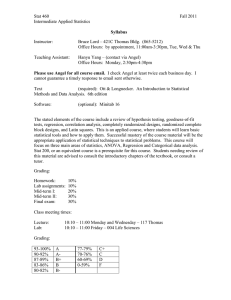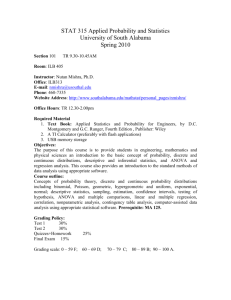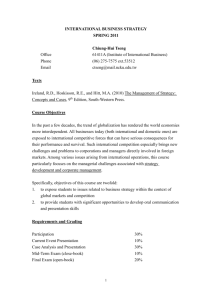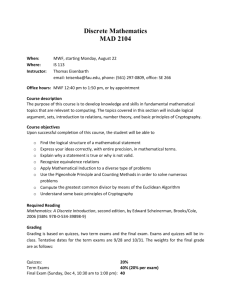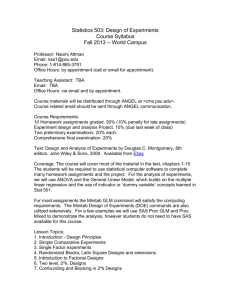stat502
advertisement
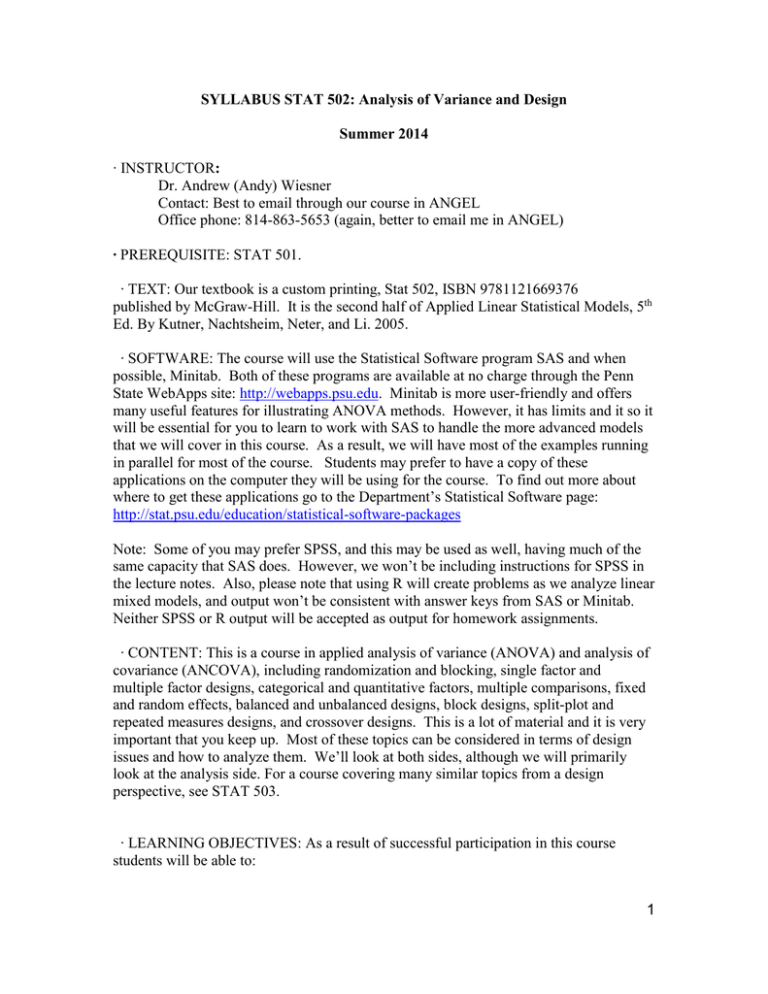
SYLLABUS STAT 502: Analysis of Variance and Design Summer 2014 ∙ INSTRUCTOR: Dr. Andrew (Andy) Wiesner Contact: Best to email through our course in ANGEL Office phone: 814-863-5653 (again, better to email me in ANGEL) ∙ PREREQUISITE: STAT 501. ∙ TEXT: Our textbook is a custom printing, Stat 502, ISBN 9781121669376 published by McGraw-Hill. It is the second half of Applied Linear Statistical Models, 5th Ed. By Kutner, Nachtsheim, Neter, and Li. 2005. ∙ SOFTWARE: The course will use the Statistical Software program SAS and when possible, Minitab. Both of these programs are available at no charge through the Penn State WebApps site: http://webapps.psu.edu. Minitab is more user-friendly and offers many useful features for illustrating ANOVA methods. However, it has limits and it so it will be essential for you to learn to work with SAS to handle the more advanced models that we will cover in this course. As a result, we will have most of the examples running in parallel for most of the course. Students may prefer to have a copy of these applications on the computer they will be using for the course. To find out more about where to get these applications go to the Department’s Statistical Software page: http://stat.psu.edu/education/statistical-software-packages Note: Some of you may prefer SPSS, and this may be used as well, having much of the same capacity that SAS does. However, we won’t be including instructions for SPSS in the lecture notes. Also, please note that using R will create problems as we analyze linear mixed models, and output won’t be consistent with answer keys from SAS or Minitab. Neither SPSS or R output will be accepted as output for homework assignments. ∙ CONTENT: This is a course in applied analysis of variance (ANOVA) and analysis of covariance (ANCOVA), including randomization and blocking, single factor and multiple factor designs, categorical and quantitative factors, multiple comparisons, fixed and random effects, balanced and unbalanced designs, block designs, split-plot and repeated measures designs, and crossover designs. This is a lot of material and it is very important that you keep up. Most of these topics can be considered in terms of design issues and how to analyze them. We’ll look at both sides, although we will primarily look at the analysis side. For a course covering many similar topics from a design perspective, see STAT 503. ∙ LEARNING OBJECTIVES: As a result of successful participation in this course students will be able to: 1 Manipulate datasets in preparation for ANOVA Recognize elements of treatment designs Differentiate between fixed and random effects Understand and be able to recognize blocking variables Construct appropriate ANOVA statistical models for experimental settings Include continuous covariates for ANCOVA Analyze repeated measures in ANOVA Apply concepts that are introduced in the class to advanced models ∙ PROCESS: The general process used for this course is to describe methodology in Online Lesson Notes and in doing this worked examples are provided. Homework assignments will include problems that are similar to worked examples from the lessons, but will also include ‘challenges’ that require extending the concepts to new experimental situations. Homework problems may also include application (and interpretation) of the lecture material to experimental situations that arise in your area of academic interest. Note: This course is highly cumulative and designed to have each weekly lesson build on the next. As such, “working ahead” is NOT allowed in this course. Please remember that this course needs to be one (of the probably many) priorities. ∙ PARTICIPATION / COMMUNICATION: Each weekly lesson will have a Discussion Forum where students can post questions regarding subject matter content. The instructors will routinely monitor these discussions and when appropriate post responses. Students are strongly encouraged to provide responses for questions. Student responses will be monitored by faculty as well. Discussion Forums will be provided for review sessions and these will be organized by topic or question. A separate Discussion Forum will also be provided for individual project work later in the course. No course content questions will be answered via email. If you submit a question to one of the faculty about course content you will be redirected to the discussion forum for your answer. Typically if you have a question about the content of the lesson others in class will also have that question. Sometimes an interesting discussion will develop among the students about it. Course (ANGEL) email is restricted to communication regarding administrative questions, grades, etc. for the faculty. Emails sent to instructors outside of the course environment will not be answered. In order for the instructors to respond to any emails in a timely fashion, they MUST be submitted through ANGEL. ∙ AVAILABILITY: Students are welcome to post messages any time in the discussion forum for a particular lesson. We will try to respond within 24 hours on business days 2 (Mon.- Fri.) and on weekends as possible. If something comes up wherein we will be away from the computer for an extended period, we will let you know. ∙ HOMEWORK: Homework (HW) is due by 12:00 midnight EST every Wednesday. All completed assignments should be saved and uploaded to the homework’s respective ANGEL drop box. Solutions to the homework will also be posted in the Homework folder and will be available following the due date. The problems will reflect material to be covered that week. The grading of homework will be done using a “0 / 100 method. If all problems are attempted and all work is shown the student will receive a 100, even if your final answer is incorrect. Otherwise, the homework will receive a 0. That is, if you do NOT attempt all problems that homework will receive a zero (0) grade. Answers must be statistical in nature (e.g. saying "I didn't understand the question" is not an acceptable answer). The purpose of this grading method is to allow students to attempt problems without fear of grading repercussions. You will be expected to compare your assignment to solutions to facilitate your understanding of the material. Most problems will involve using software. All submitted assignments involving software must include the output with the relevant portions marked. You are encouraged to discuss homework problems with classmates via weekly discussion boards in ANGEL. We will monitor these (as well as course email) daily Monday-Friday and weekends as possible to respond to questions as they arise. Submissions of Homework and Exams is done through a Dropbox in ANGEL provided with the assignment. These will consist of a single file IN WORD DOCUMENT (.doc or docx extension) FORMAT!! Also, one important part of an ANOVA course is the model statements. For all the designs we discuss, the book and the notes contain model statements. Since the model statements are so important, we may ask you to give them on homework assignments or tests. As mentioned above, you’ll need a way to write Greek letters write subscripts and write simple algebraic expressions. Microsoft Word will do this by using the Insert > Equation function. With a little practice, this is not difficult to work with. ∙ TESTS: Two open book exams, and a proctored comprehensive final exam. Students are expected to do their own work on exams and no Discussion Forum will be available on ANGEL for the exams and no questions will be entertained during the exam period. For exam questions, if two answers are provided, the incorrect one will be graded. Exam solutions we be posted following completion of grading. ∙ INDIVIDUAL PROJECT: Each student will find an interesting ANOVA or ANCOVA data set from his or her own area of application, analyze it, and write a report on it. The projects will be completed on an individual-student basis. The project should not be a regression analysis or analyze count data. Regression methods can however be included 3 in the context of Analysis of Covariance (ANCOVA). The project must have a full discussion of interpretations (including graphs), not just a statement of results. ∙ GRADING: Weekly Homework Exams (2 Mid-terms and 1 Final – 20% each) Individual Project 20% 60% 20% Grading Scale F D C C+ B- B B+ A- A 0 60 70 77 80 82 88 90 93 Academic Integrity Statement: All Penn State policies regarding ethics and honorable behavior apply to this course. Academic integrity is the pursuit of scholarly activity free from fraud and deception and is an educational objective of this institution. All University policies regarding academic integrity apply to this course. Academic dishonesty includes, but is not limited to, cheating, plagiarizing, fabricating of information or citations, facilitating acts of academic dishonesty by others, having unauthorized possession of examinations, submitting work of another person or work previously used without informing the instructor, or tampering with the academic work of other students. For any material or ideas obtained from other sources, such as the text or things you see on the web, in the library, etc., a source reference must be given. Direct quotes from any source must be identified as such. Tests and projects are to be individual work. All exam answers must be your own, and you must not provide any assistance to other students during exams. Any instances of academic dishonesty WILL be pursued under the University and Eberly College of Science regulations concerning academic integrity. For more information on academic integrity, see Penn State's statement on plagiarism and academic dishonesty . The Eberly College of Science Code of Mutual Respect and Cooperation embodies the values that we hope our faculty, staff, and students possess and will endorse to make The Eberly College of Science a place where every individual feels respected and valued, as well as challenged and rewarded. 4 Accommodations For Students with Disabilities: Penn State welcomes students with disabilities into the University's educational programs. If you have a disability-related need for reasonable academic adjustments in this course, contact the Office for Disability Services (ODS) at 814-863-1807 (V/TTY). For further information regarding ODS, please visit the Office for Disability Services Web site at http://equity.psu.edu/ods/ . In order to receive consideration for course accommodations, you must contact ODS and provide documentation (see the documentation guidelines at http://equity.psu.edu/ods/student-information ). If the documentation supports the need for academic adjustments, ODS will provide a letter identifying appropriate academic adjustments. Please share this letter and discuss the adjustments with your instructor as early in the course as possible. You must contact ODS and request academic adjustment letters at the beginning of each semester. 5
